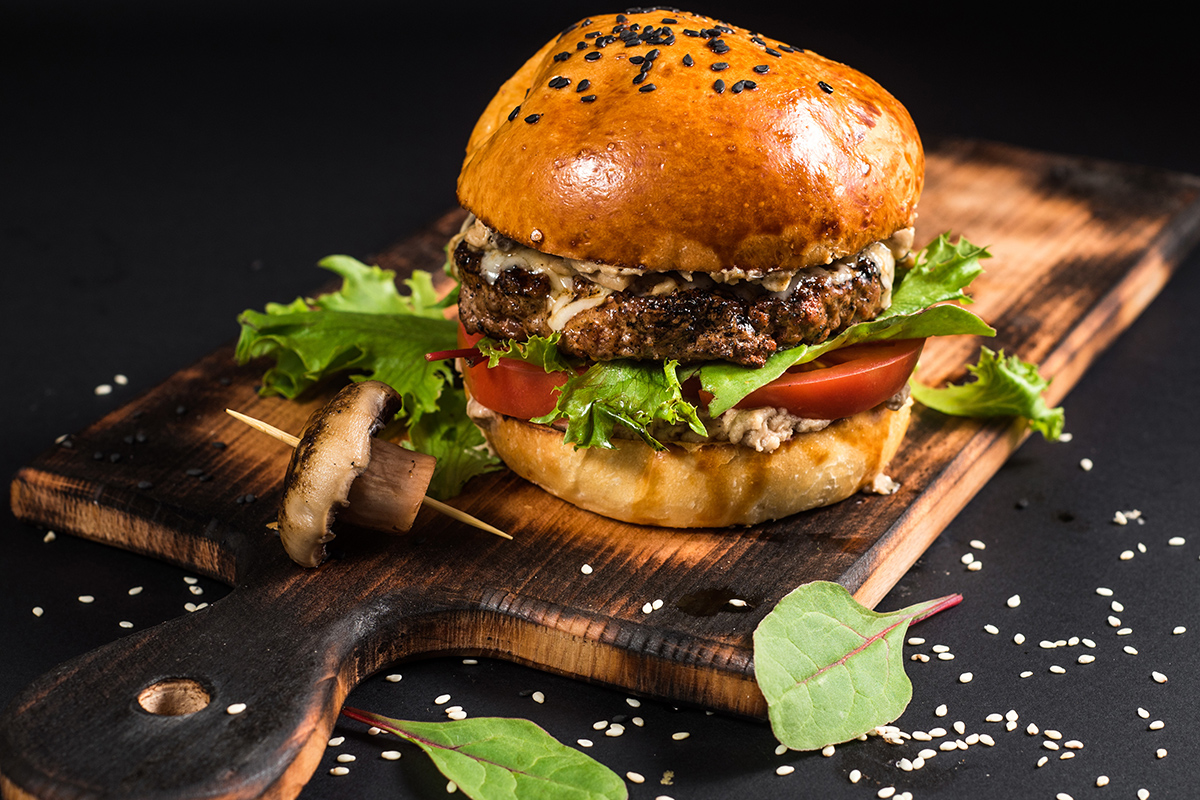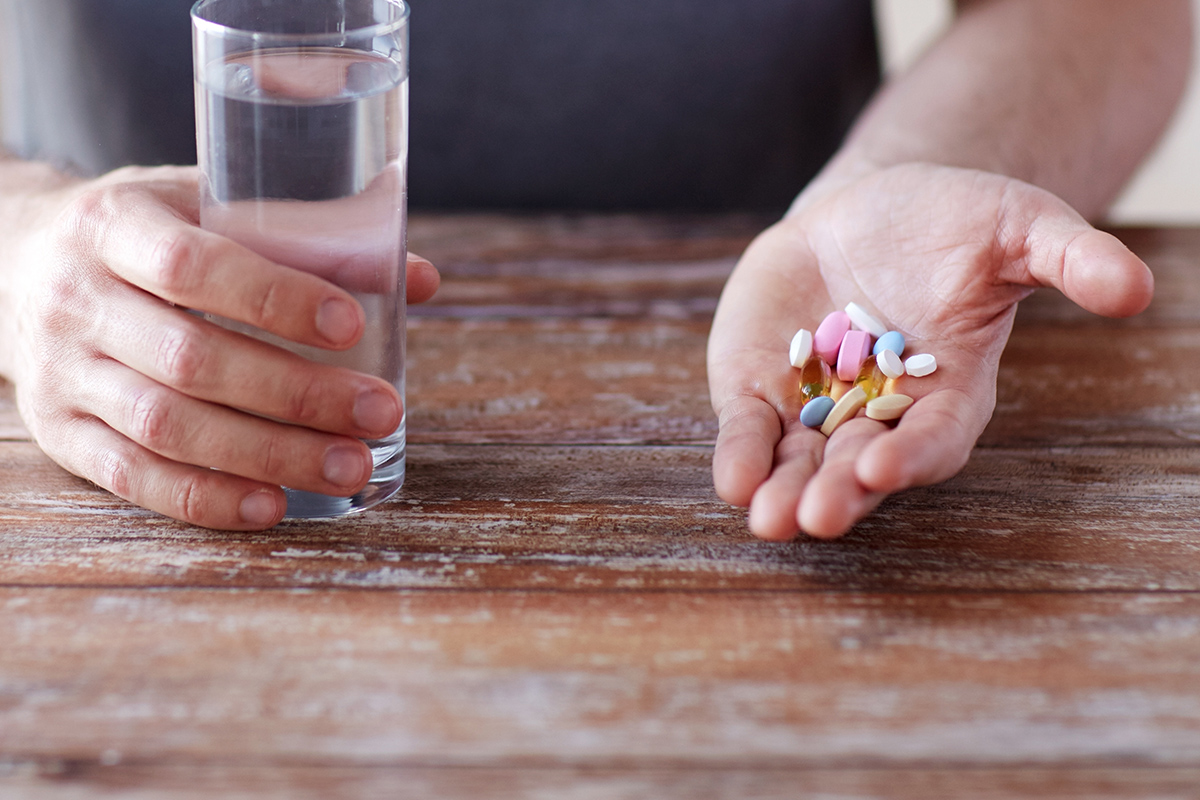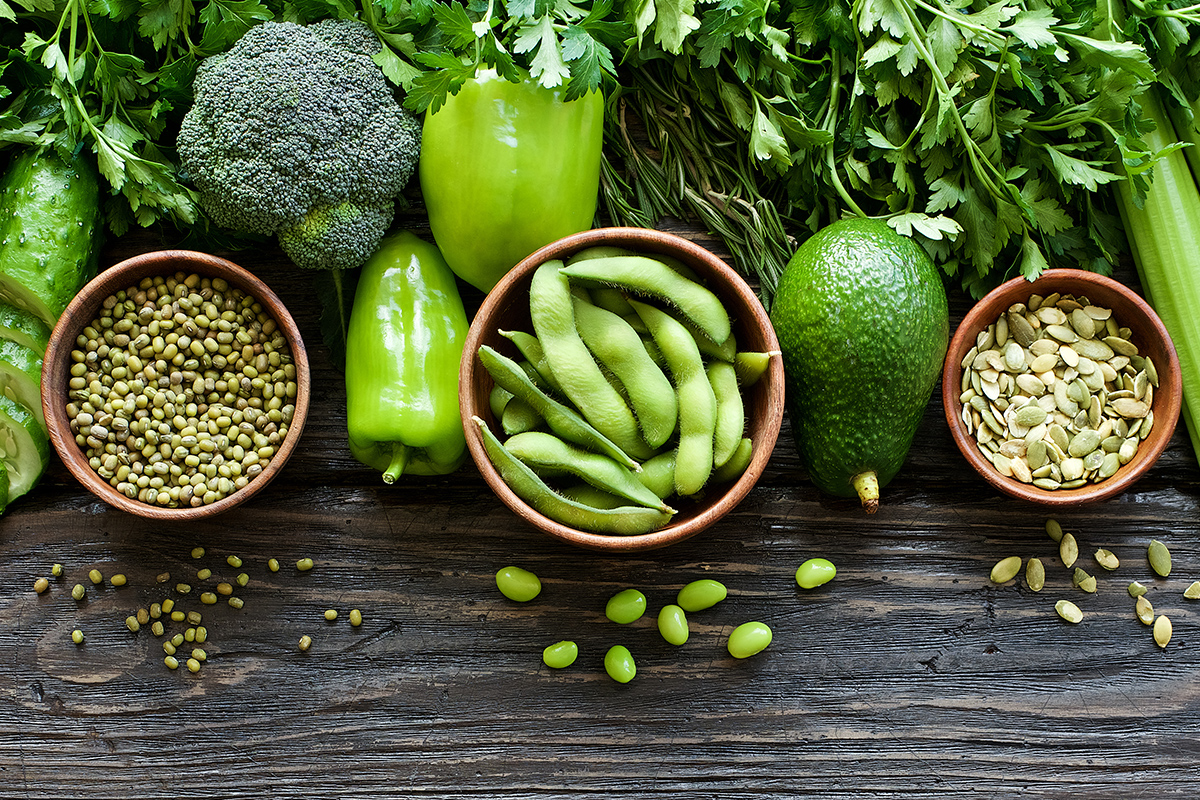Salt Grains for Muscle Gains?
Does liberally salting your food help you pump more iron in the gym? Registered Dietitian, Debbie James, investigates the claims!

Meatless burgers that bleed and have the taste and mouthfeel of cooked ground beef are here to stay! Whether from restaurants or the grocery store, these next generation meat analog products are seemingly everywhere. Curious or health-conscious carnivores are happy to gobble down mock meat foods in an attempt to reduce their risk of cancer or heart disease while many vegetarians embrace the convenience of these prepared plant products. Now there are even blended patties combining beef with plant proteins to please every omnivore and flexitarian.
| Did you know? The first commercially available veggie patty was from an English “VegeBurger” mix in 1982, according to www.Smithsonian.com. |
Beef is from nature and beans are from nature… But highly processed foodstuffs made from either of them aren’t as healthy and definitely aren’t considered natural. Fresh, lean red meat offers high-quality protein, is rich in niacin, selenium, zinc, and vitamins B6 and B12, and is a good source of potassium. Unfortunately, the way typical Americans prepare ground beef – exposed to high heat until charred – creates compounds harmful to health1. With the newer meat analogs, there’s a concern over preservatives, sodium, additives like smoke flavor, artificial colors, and other factory-derived proprietary ingredients2.
Sure, we can pick them apart individually* and talk about isolated ingredients, but it may be wise to focus on the bigger picture of one’s overall diet first3. Health agencies and experts most often recommend a varied diet rich in antioxidants and vegetables, moderate in fat, with adequate micronutrients, protein and fiber1. So, it makes a difference if these newer veggie burgers replace meat or take the place of raw plant foods, and how often they do so.
There’s a growing body of research supporting the risks of red meat consumption1 and the health benefits of replacing animal proteins with plant proteins4. Compared to pure ground beef patties, plant-based burgers are naturally devoid of cholesterol and vitamin B12, may be lower in saturated fat, are higher in fiber, but are also higher in sodium3. Compared with traditional DIY veggie patty recipes that call for minimal ingredients (beans, grains, vegetables, and mushrooms), they’re lower in fiber and are higher in sodium.
One of the major differences between the current next generation plant patties and other processed legume-based burgers (such as Morningstar Farm® Grillers) is in their appearance and texture to replicate the experience of eating meat. You can thank a few choice ingredients for the aroma, flavor and look of meat-like patties.

A side-by-side nutritional comparison showed that Impossible Burger, Beyond Burger™, and 85% lean real beef have similar protein content (19-21 grams per 4 ounces)5. Soy and pea protein are the primary protein contributors in the new analogs, making them higher in protein than veggie burgers which never contained beans (such as Gardenburger® Original).
Still, they differ from legumes in traditional bean-based burgers (e.g. BOCA burger, Dr. Praeger’s® Heirloom Bean) in that they are refined — and that’s not such a bad thing. Digestion of isolated proteins is slightly greater than whole plant food protein4 while the digestibility score of soy protein is about 97%, one of the highest for plant proteins. Isolating the protein from beans leaves out the natural factors that inhibit protein digestion4, so for the newer meatless patties there could be greater protein digestibility than from traditional whole bean burgers.

A compound synthetically derived from methyl chloride treatment of cellulose, a plant cell structural component, it is used as a thickening and/or gelling agent in processed foods and as a natural laxative. As a high-viscosity fiber, some studies show methylcellulose may help blunt blood sugar response to a meal6 and relieve constipation.

A convincing meaty appearance often comes from the addition of beets which impart a vibrant color, mimicking the juiciness of beef. Omnivores and cross-over carnivores see the ‘bleed’ as a positive burger characteristic, just as most people expect grill marks on a patty. Beets offer not only color, but a sweet, earthy flavor and nutrients such as folate, manganese, potassium plus the antioxidant betaine.

Plant burgers with legume heme as a color additive may also sizzle and smell like real meat4. Legume hemoglobin (called legume heme for short) is a plant-derived oxygen carrier similar to blood hemoglobin and has a distinct red color which releases upon heating5.

It contains both mono and polyunsaturated fats, vitamin E, and cholesterol lowering phytosterols5. Sounds good but some studies have shown that it releases hazardous aldehydes when it’s used in high-heat cooking, such as frying5.
Overall, the newer meatless burgers provide a needed cross over for people wanting to incorporate more healthy plant-based foods by replacing the all-American favorite beef hamburger. For omnivores, these mock meats allow a seamless transition in the burger category. However, those already eating a (mainly) plant only diet may be better served by sticking to whole food ingredients for their health unless they have issues obtaining sufficient protein.
* Numerous meatless burger products abound – too many to mention. Inclusion of or exclusion of any particular brand name does not imply recommendation against or endorsement for that brand’s product(s). Products mentioned are for consumer reference and comparison only.


What is the best type of recovery drink that can help my muscles recover quicker from exercising?
– David A.

The optimum content of your recovery drink depends on the type of exercise, intensity and duration.
Stop by your club’s juice bar to see what’s likely to fit into your recovery nutrition. No matter what you choose, remember to consider portion/energy since some shakes can contain over 300 calories and may surpass what was burned during the exercise!
– Debbie J., MS, RD
This article should not replace any exercise program or restrictions, any dietary supplements or restrictions, or any other medical recommendations from your primary care physician. Before starting any exercise program or diet, make sure it is approved by your doctor.
Some questions have been edited for length and/or clarity.
 Have a nutrition question? Our registered dietitian is ready to help!
Have a nutrition question? Our registered dietitian is ready to help!
Email nutrition@lafitness.com or submit your question below and it may be featured in an upcoming article!
Does liberally salting your food help you pump more iron in the gym? Registered Dietitian, Debbie James, investigates the claims!
Debbie James, RDN, helps answer a question about energizing snack options to pull athletes through the second half of a high energy workout.
Registered Dietitian, Debbie James, helps answer a reader’s question about a good nutrition guide for a healthy pregnancy.


Good evening. I am a 53-year-old male and I was hearing that I should be taking fish oil, a multivitamin, B-12, vitamin D, magnesium, and creatine. Do you agree? And what do you recommend in terms of dosage for the fish oil, vitamin d, magnesium and creatine? Do you recommend any others as well?
Thank you for your time.
– Jeff

If your multivitamin (usually has minerals too) supplement provides close to 100% of the Daily Value for micronutrients, then you probably don’t need additional vitamin B12 or D. Most “once daily” multi’s are meant to cover the bases of micronutrient needs, but they vary greatly. A quick glance at a few widely available products (Centrum for Men, One a Day Men’s Formula, Nature Made Multi for Him) reveals they are rather low in magnesium, which is on purpose because the risk of toxicity is greater from supplemental magnesium than from foods. Though the Daily Value for magnesium is 420 mg for men, the maximum advised from supplements is only 350 mg daily1. Get the remainder of your magnesium intake from good sources such as almonds, spinach, cashews, peanuts, shredded wheat cereal, soymilk, black beans, edamame, peanut butter, wheat bread, avocado, baked potato, brown rice and plain yogurt1.
Fish oil contains the omega-3 fatty acids, eicosapentaenoic acid (EPA) and docosahexaenoic acid (DHA). There is no set Adequate Intake for EPA and DHA, only for another omega-3: alpha lipoic acid (ALA) from plant sources2. It’s recommended to eat fish twice per week and walnuts, chia seed or flaxseed daily to obtain omega-3 naturally from the diet. Generally, a combined EPA+DHA dose of 300-500 mg per day is suggested for anti-inflammation but higher levels may be warranted for certain health conditions. For cardio protection there may be benefit for African-Americans and non-fish eaters to take 1,000 mg supplemental omega-3 daily3, and higher doses by prescription.
Creatine works by providing ready energy for muscle contractions in the form of ATP. Whether or not you’d benefit from a creatine supplement depends on your exercise routine and goals. About 3-6 grams pre-workout has been shown to increase creatine stores and affect strength gains accompanying weight training4, and is relatively safe to take. You can get creatine from protein-rich foods and your body makes some, thus it’s not worth supplementing if you don’t participate in short duration high-intensity resistance exercise.
References:
– Debbie J., MS, RD
This article should not replace any exercise program or restrictions, any dietary supplements or restrictions, or any other medical recommendations from your primary care physician. Before starting any exercise program or diet, make sure it is approved by your doctor.
Some questions have been edited for length and/or clarity.
 Have a nutrition question? Our registered dietitian is ready to help!
Have a nutrition question? Our registered dietitian is ready to help!
Email nutrition@lafitness.com or submit your question below and it may be featured in an upcoming article!
Does liberally salting your food help you pump more iron in the gym? Registered Dietitian, Debbie James, investigates the claims!
Debbie James, RDN, helps answer a question about energizing snack options to pull athletes through the second half of a high energy workout.
Registered Dietitian, Debbie James, helps answer a reader’s question about a good nutrition guide for a healthy pregnancy.


Are you able to help me with calorie recommendations? In the last 8 months I have lost almost 60 pounds through diet. I started going to the gym 4-5 days a week and seeing a trainer 1 day a week. My weight loss has virtually stalled in the past month. I don’t know if my calories are too high or too low.
I am a 57-year-old male and I currently weigh 254 pounds. I am eating between 1,400 and 1,800 calories a day. Based on the online diet calculations I should be eating 1,900 calories a day to lose 2 pounds a week. I use Apple Watch to track calories and usually burn between 400 and 800 calories a day more in exercise calories. I never eat back the exercise calories. Thanks for your thoughts.
– Doug S.

A brief month stall is a blink in your profound progress over the last year, Doug. It sounds like your metabolism has adapted to the diet and exercise routine you’ve set up. Time to shake things up!
What your calories are comprised of makes a big difference in whether you’ll store or burn fat. Since you’ve already done the math and determined your intake is lower than suggested, I’d say try adding a couple hundred calories in vegetables, legumes and pre-workout shakes or recovery drinks on exercise days. Don’t add more if you feel satisfied at your present intake.
Assuming your training workouts are progressing, focus on amping up your gym visits on the other days. You may benefit from a new exercise like a high intensity interval training (HIIT) class, harder weights/resistance, or increased cardio duration. Also look at your daily activity outside the gym and try to increase movement whenever possible.
Remember that weight loss and body composition change aren’t linear, but usually occur with ups and downs. The fact that you are consistent in your exercise routine and dietary tracking means you’re very likely to see results again soon. Read more about overcoming plateaus in the Living Healthy blog, here and here.
– Debbie J., MS, RD
This article should not replace any exercise program or restrictions, any dietary supplements or restrictions, or any other medical recommendations from your primary care physician. Before starting any exercise program or diet, make sure it is approved by your doctor.
Some questions have been edited for length and/or clarity.
 Have a nutrition question? Our registered dietitian is ready to help!
Have a nutrition question? Our registered dietitian is ready to help!
Email nutrition@lafitness.com or submit your question below and it may be featured in an upcoming article!
Does liberally salting your food help you pump more iron in the gym? Registered Dietitian, Debbie James, investigates the claims!
Debbie James, RDN, helps answer a question about energizing snack options to pull athletes through the second half of a high energy workout.
Registered Dietitian, Debbie James, helps answer a reader’s question about a good nutrition guide for a healthy pregnancy.


As a newly diagnosed diabetic, what supplements can I take that will not spike my blood sugar? 2 months ago, I started a cardio program at home, but I want to start weight training.
-Jose

Kudos to rounding out your exercise routine!
To narrow down an answer, I’ll have to assume you are asking about pre-workout powders, meal replacement bars, recovery shakes and other sports/body-building supplements with macronutrients (carbohydrate, fat, and protein) not individual compounds, like stimulants. Caffeine may reduce sensitivity of insulin and raise blood sugar levels.
Generally, single servings of products with only protein and fat shouldn’t raise blood sugar levels. Many “keto-safe” protein shakes, powders and bars fall into this category. Still, they are designed for fast digestion and absorption, making a quicker impact on insulin levels than whole foods which take longer to consume and digest. Consider making your own protein beverages to drink pre and post workout.
Products with any sugar present should also have fiber plus a balance of protein and fat, to prevent blood sugar spikes. Check the nutrition facts panel for gram levels of these. There are no magic numbers, but I would recommend avoiding products with half of total carbohydrates from sugar and those with more than 10 grams of sugar per serving. You should look at what you’re eating between meals, too. Several snack bars are promoted for those with diabetes.
Unfortunately, there are no guarantees how your blood sugar will respond to even the most low-risk caloric supplement. No matter what supplements you take, always follow the usage directions on the product package.
– Debbie J., MS, RD
This article should not replace any exercise program or restrictions, any dietary supplements or restrictions, or any other medical recommendations from your primary care physician. Before starting any exercise program or diet, make sure it is approved by your doctor.
Some questions have been edited for length and/or clarity.
 Have a nutrition question? Our registered dietitian is ready to help!
Have a nutrition question? Our registered dietitian is ready to help!
Email nutrition@lafitness.com or submit your question below and it may be featured in an upcoming article!
Does liberally salting your food help you pump more iron in the gym? Registered Dietitian, Debbie James, investigates the claims!
Debbie James, RDN, helps answer a question about energizing snack options to pull athletes through the second half of a high energy workout.
Registered Dietitian, Debbie James, helps answer a reader’s question about a good nutrition guide for a healthy pregnancy.
Be the first to know about exclusive
content, deals and promotions